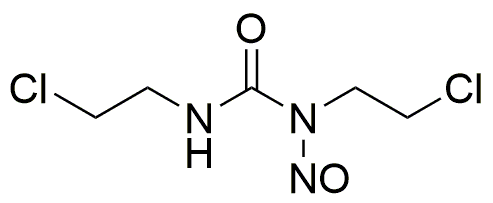Carmustine is widely utilized in research focused on:
- Cancer Treatment: Primarily used as a chemotherapy agent for treating various types of cancers, including brain tumors and multiple myeloma. Its ability to cross the blood-brain barrier makes it particularly effective for central nervous system cancers.
- Veterinary Medicine: Employed in veterinary oncology for treating tumors in pets, providing an option for pet owners seeking advanced treatment for their animals.
- Research Applications: Utilized in laboratory settings to study cancer cell behavior and resistance mechanisms, helping researchers develop new therapeutic strategies.
- Drug Formulation: Incorporated in the development of combination therapies, enhancing the effectiveness of other anticancer drugs and reducing the likelihood of drug resistance.
- Pharmaceutical Development: Serves as a model compound in the synthesis of new nitrosourea derivatives, aiding in the discovery of novel anticancer agents with improved efficacy and safety profiles.
General Information
Properties
Safety and Regulations
Applications
Carmustine is widely utilized in research focused on:
- Cancer Treatment: Primarily used as a chemotherapy agent for treating various types of cancers, including brain tumors and multiple myeloma. Its ability to cross the blood-brain barrier makes it particularly effective for central nervous system cancers.
- Veterinary Medicine: Employed in veterinary oncology for treating tumors in pets, providing an option for pet owners seeking advanced treatment for their animals.
- Research Applications: Utilized in laboratory settings to study cancer cell behavior and resistance mechanisms, helping researchers develop new therapeutic strategies.
- Drug Formulation: Incorporated in the development of combination therapies, enhancing the effectiveness of other anticancer drugs and reducing the likelihood of drug resistance.
- Pharmaceutical Development: Serves as a model compound in the synthesis of new nitrosourea derivatives, aiding in the discovery of novel anticancer agents with improved efficacy and safety profiles.
Documents
Safety Data Sheets (SDS)
The SDS provides comprehensive safety information on handling, storage, and disposal of the product.
Product Specification (PS)
The PS provides a comprehensive breakdown of the product’s properties, including chemical composition, physical state, purity, and storage requirements. It also details acceptable quality ranges and the product's intended applications.
Certificates of Analysis (COA)
Search for Certificates of Analysis (COA) by entering the products Lot Number. Lot and Batch Numbers can be found on a product’s label following the words ‘Lot’ or ‘Batch’.
*Catalog Number
*Lot Number
Certificates Of Origin (COO)
This COO confirms the country where the product was manufactured, and also details the materials and components used in it and whether it is derived from natural, synthetic, or other specific sources. This certificate may be required for customs, trade, and regulatory compliance.
*Catalog Number
*Lot Number
Safety Data Sheets (SDS)
The SDS provides comprehensive safety information on handling, storage, and disposal of the product.
DownloadProduct Specification (PS)
The PS provides a comprehensive breakdown of the product’s properties, including chemical composition, physical state, purity, and storage requirements. It also details acceptable quality ranges and the product's intended applications.
DownloadCertificates of Analysis (COA)
Search for Certificates of Analysis (COA) by entering the products Lot Number. Lot and Batch Numbers can be found on a product’s label following the words ‘Lot’ or ‘Batch’.
*Catalog Number
*Lot Number
Certificates Of Origin (COO)
This COO confirms the country where the product was manufactured, and also details the materials and components used in it and whether it is derived from natural, synthetic, or other specific sources. This certificate may be required for customs, trade, and regulatory compliance.

